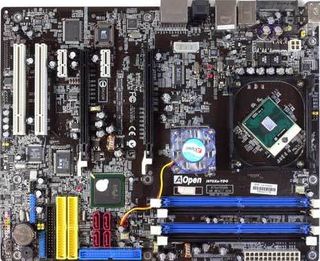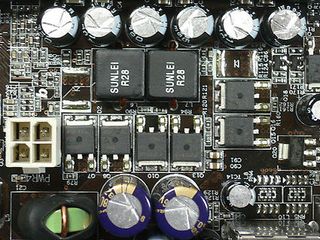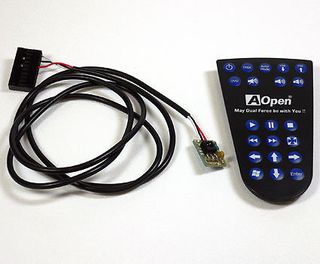AOpen Releases Core Duo To The Desktop
AOpen I975Xa-YDG

Were it not for the strange, small processor socket that reminds one of the Pentium 4's former Socket 478, this motherboard would look like any other Intel chipset motherboard. Since it uses the 975X chipsets, there are two PCI Express x16 slots, which can be used for dual graphics setups based on ATI's Crossfire technology. The slots are positioned three slots away from each other, supporting high end graphics cards that require two slots due to their massive heat sinks.
The chipset supports DDR2-667 memory and a system speed up to FSB1066, which theoretically means a great basis for overclocking. Unfortunately, there were not many BIOS features available to support excessive overclocking opportunities... at least, not yet. FSB667 is Core Duo's stock system speed (166 MHz quad pumped), and it can be raised up to FSB 796 (199 MHz). We did not find BIOS settings to alter the multiplier, which is possible due to the fact that all processors that support SpeedStep are multiplier unlocked.
When playing around with the memory, we found a little bug: Setting fast CL3-3-3-8 timings made the system run at CL3-3-3-12. All our benchmark runs were done at CL4-4-4-12, since we did not have enough time to ensure system stability at tight timings before conducting our benchmarks.
The chipset's Northbridge requires a heatsink and fan, which we don't like, especially since the Northbridge fan turned out to be as noisy as the processor fan at low RPM. Not good boys - this needs to be reworked. AOpen added an external SATA connector to the back panel, and support for IEEE-1394a/Firewire through a chip by Agere. A small ITE UltraATA/133 controller compensates the interface shortcomings of the ICH7R Southbridge - as long as SATA optical drives remain few and far between, two UltraATA ports will continue to be a must-have.




Stay on the Cutting Edge
Join the experts who read Tom's Hardware for the inside track on enthusiast PC tech news — and have for over 25 years. We'll send breaking news and in-depth reviews of CPUs, GPUs, AI, maker hardware and more straight to your inbox.
Current page: AOpen I975Xa-YDG
Prev Page Intel Core Duo Vs. Pentium D Next Page Intel's Platform Power RoadmapMost Popular

